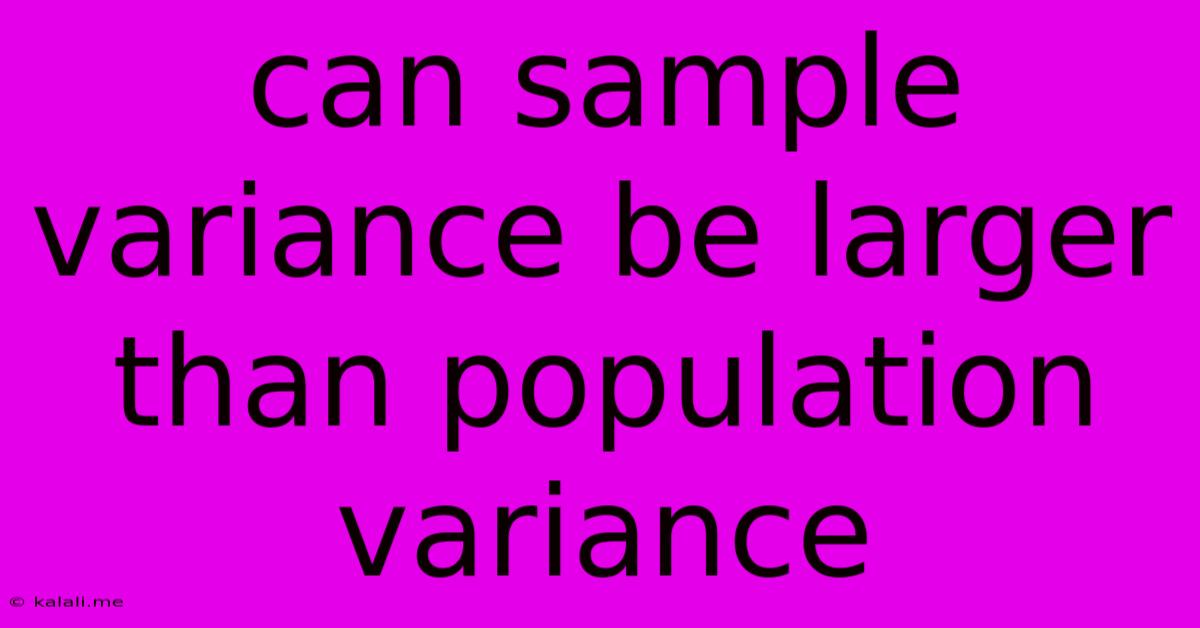Can Sample Variance Be Larger Than Population Variance
Kalali
May 28, 2025 · 3 min read

Table of Contents
Can Sample Variance Be Larger Than Population Variance? A Deep Dive into Statistical Estimation
Meta Description: Understanding the relationship between sample and population variance is crucial in statistics. This article explores whether a sample variance can be larger than the population variance, explaining the underlying concepts and providing illustrative examples.
The question of whether a sample variance can be larger than the population variance is a common one in introductory statistics. The short answer is: yes, absolutely. While it might seem counterintuitive at first – shouldn't the sample perfectly represent the population? – the reality is more nuanced. Let's delve into the reasons why this is possible and what it means for statistical inference.
Understanding Variance
Before diving into the comparison, let's refresh our understanding of variance. Variance measures the spread or dispersion of a dataset around its mean. A higher variance indicates greater variability, while a lower variance suggests data points are clustered more tightly around the mean.
-
Population Variance: This represents the true variance of the entire population. It's calculated using all data points within the population. We denote population variance as σ² (sigma squared).
-
Sample Variance: This is an estimate of the population variance, calculated from a subset (sample) of the population data. We denote sample variance as s² (s squared). The formula for sample variance uses a denominator of n-1 (where n is the sample size), a crucial detail that impacts its relationship with the population variance. This is known as Bessel's correction and helps to reduce bias in the estimation.
Why Sample Variance Can Be Larger
The reason sample variance can exceed population variance stems from the inherent randomness of sampling. When you select a sample, you're not guaranteed a perfect miniature representation of the population. Several scenarios can lead to a larger sample variance:
-
Unlucky Sample: Pure chance can lead to a sample that contains more extreme values than the overall population. This happens more frequently in smaller samples. Imagine drawing a sample of heights from a population; a sample that accidentally includes unusually tall individuals might have a higher variance than the overall population.
-
Sampling Bias: A biased sampling method can skew the sample variance. If the sampling method systematically favors certain parts of the population, the resulting sample might not accurately reflect the overall population variance. For example, surveying only one demographic might yield a sample variance that doesn't represent the wider population.
Illustrative Example
Let's consider a simple example. Imagine a population with the following values: {2, 4, 6, 8, 10}. The population variance (σ²) is 8.
Now, let's draw a sample: {2, 10}. The sample variance (s²) is 32, which is significantly larger than the population variance. This illustrates how a small, unrepresentative sample can lead to an overestimation of the population variance. A larger sample would likely yield a sample variance closer to the population variance.
Implications for Statistical Inference
The possibility of sample variance being larger than population variance highlights the importance of understanding sampling variability and the limitations of using sample statistics to infer population parameters. Larger samples generally improve the accuracy of estimations, reducing the chance of significant discrepancies between sample and population variances. Proper statistical techniques account for this variability and allow for reasonable inferences about the population based on the sample data, even when the sample variance is larger than the population variance.
Conclusion
In conclusion, while it might seem counterintuitive, a sample variance can indeed be larger than the population variance. This is due to the randomness of sampling and the possibility of obtaining an unrepresentative sample. Understanding this phenomenon is crucial for accurate statistical inference and highlights the importance of using appropriate sampling techniques and considering the limitations of sample statistics when drawing conclusions about a population. The size of the sample plays a critical role in the accuracy of this estimation.
Latest Posts
Latest Posts
-
Zero Lift Line For A Wing
May 29, 2025
-
Funny Response To Someone Who Speaks Off Topic
May 29, 2025
-
Install Mac Os To Run Idle On Terminal With Pyenv
May 29, 2025
-
Record Is Not Createable Flow Field Error
May 29, 2025
-
Wiring Diagram For Three Phase Motor
May 29, 2025
Related Post
Thank you for visiting our website which covers about Can Sample Variance Be Larger Than Population Variance . We hope the information provided has been useful to you. Feel free to contact us if you have any questions or need further assistance. See you next time and don't miss to bookmark.